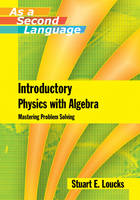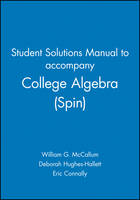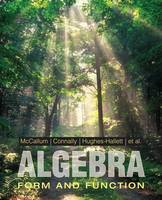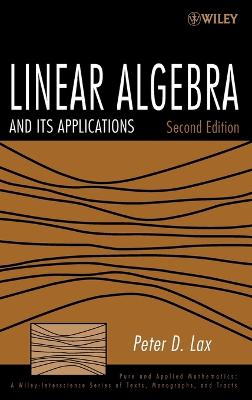Introductory Physics with Algebra as a Second Language
 -15%
portes grátis
-15%
portes grátis
Introductory Physics with Algebra as a Second Language
Mastering Problem-Solving
Loucks, Stuart E.
John Wiley & Sons Inc
08/2006
288
Mole
Inglês
9780471762508
15 a 20 dias
436
Descrição não disponível.
CHAPTER 1 THE BOTTOM LINE FOR SOLVING PHYSICS PROBLEMS 1
CHAPTER 2 LINEAR VELOCITY AND ACCELERATION 3
2.1 Linear Motion Equations 3
2.2 The Idea Behind How to Use Motion Equations 4
2.3 Constant/Average Speed or Velocity Problems 5
2.4 Constant/Average Speed or Velocity-Two Intervals, Same Direction 6
2.5 Constant/Average Speed or Velocity-Two Intervals, Direction Change 10
2.6 Constant/Average Speed or Velocity-Two Objects 13
2.7 How to Set Up Constant/Average Speed or Velocity Problems 15
2.8 Constant/Average Acceleration Problems 16
2.9 Constant/Average Acceleration-One Interval 17
2.10 Constant/Average Acceleration-Multiple Intervals 20
2.11 Constant/Average Acceleration-"Free-Fall" 22
2.12 Constant/Average Acceleration-Two Objects 27
2.13 How to Set Up Constant/Average Acceleration Problems 29
CHAPTER 3 VECTORS 31
3.1 Magnitude and Direction, and x- and y-Components 31
3.2 Vectors along One Axis 37
3.3 Vector Addition 38
3.4 How to Set Up Vector Problems 42
3.5 "Back Where You Started"-When Vectors Add to Zero 42
3.6 Subtracting Vectors, OR, When One of the Added Vectors Is Unknown 45
CHAPTER 4 PROJECTILE MOTION 49
4.1 Projectile Motion: Combining Three Basic Concepts 49
4.2 When Initial Velocity Is Horizontal 50
4.3 How to Set Up Projectile Motion Problems 55
4.4 When Final Velocity Is Horizontal (at Maximum Height) 56
4.5 When Initial and Final Heights Are Equal 61
4.6 When Both Initial and Final Velocities Are at Angles 62
CHAPTER 5 FORCE AND NEWTON'S LAWS OF MOTION 69
5.1 How to Draw a Free-Body Diagram (FBD) 70
5.2 Forces in 1D 72
5.3 How to Set Up Force Problems 75
5.4 Motion Intervals in Force Problems 76
5.5 Objects Connected by Strings, Ropes, and so on 80
5.6 Forces in 2D 83
5.7 Sliding-Kinetic Friction 86
5.8 "Just about to Slip"-Maximum Static Friction 90
5.9 Inclines or Ramps 93
5.10 Objects Pushing on Each Other 97
CHAPTER 6 CIRCULAR MOTION AND CENTRIPETAL FORCE 100
6.1 Tangential Speed and Centripetal Acceleration 100
6.2 Comparing Circular Motion at Two Different Radii 101
6.3 Comparing Circular Motion at Two Different Speeds 102
6.4 How to Set Up Circular Motion Comparison Problems 103
6.5 How to Think about Centripetal Force Problems 104
6.6 Circular Motion with a Horizontal String 105
6.7 How to Set Up Centripetal Force Problems 107
6.8 Circular Motion with a String at an Angle 107
6.9 Circular Motion on an Unbanked Road with Friction 111
6.10 Circular Motion on a Banked Road without Friction 113
6.11 Vertical Circular Motion-Lowest Point 117
6.12 Vertical Circular Motion-Highest Point, Upside-Down 118
6.13 Vertical Circular Motion-Highest Point, Right-Side-Up 121
CHAPTER 7 GRAVITATION AND ORBITS 123
7.1 Weight and g at a Planet's Surface 123
7.2 Adding Gravitational Force Vectors 125
7.3 Circular Orbit Problems 129
7.4 Circular Orbit Equations 133
7.5 Comparing Orbits at Two Different Radii 134
CHAPTER 8 WORK AND ENERGY 136
8.1 Work Done by a Constant/Average Force 136
8.2 Work Problems-with Two or More Forces 137
8.3 Work Problems-when Forces Are Not Given 140
8.4 How to Set Up Work Problems 147
8.5 The Work-Energy Theorem-KE Only 148
8.6 How to Set Up Work-Energy Problems-KE only 153
8.7 Potential Energy, Conservative and Nonconservative Forces 154
8.8 The Work-Energy Theorem-KE and PE 155
8.9 How to Set Up Work-Energy Problems-KE and PE 161
8.10 Conservation of Energy-When Wnc = 0 162
8.11 How to Set Up Conservation of Energy Problems 166
8.12 How to Split Up a Difficult Problem 166
CHAPTER 9 IMPULSE, MOMENTUM, AND CENTER OF MASS 170
9.1 The Impulse-Momentum Theorem 170
9.2 1D Impulse and Momentum 172
9.3 2D Impulse and Momentum 174
9.4 How to Set Up Impulse and Momentum Problems 178
9.5 Conservation of Momentum 179
9.6 1D Collisions-Objects Coming Together 181
9.7 1D Explosions-Objects Pushing Apart 183
9.8 1D Elastic Collisions 185
9.9 2D Collisions 189
9.10 How to Set Up Conservation of Momentum Problems 195
9.11 Center of Mass 196
9.12 1D Center of Mass 196
9.13 2D Center of Mass 198
9.14 How to Set Up Center of Mass Problems 201
CHAPTER 10 ANGULAR VELOCITY AND ACCELERATION 202
10.1 How to Relate Angular and Tangential or Linear Quantities 202
10.2 Two-Object, Two-Circle Problems 204
10.3 How to Set up two-Object, Two-Circle Problems 208
10.4 Constant/Average Angular Velocity 209
10.5 How to Set Up Constant/Average Angular Velocity Problems 212
10.6 Constant/Average Angular Acceleration 212
10.7 Constant/Average Angular Acceleration-Multiple Intervals 215
10.8 Constant/Average Angular Acceleration-with Tangential or Linear Acceleration 218
10.9 Constant/Average Angular Acceleration-with Centripetal Acceleration 223
10.10 Summary of Angular Velocity and Acceleration Equations 226
10.11 How to Set Up Constant/Average Angular Acceleration Problems 227
CHAPTER 11 TORQUE AND EQUILIBRIUM 228
11.1 Torque 228
11.2 How to Set Up Torque Problems 231
11.3 Equilibrium for "Rigid" Bodies 232
11.4 Equilibrium-With Only 90 degrees Angles 232
11.5 Equilibrium-With Non-90 degrees Angles 245
11.6 How to Set Up Equilibrium Problems 251
CHAPTER 12 MORE ANGULAR MOTION 252
12.1 Moment of Inertia 252
12.2 Torque and Angular Acceleration Problems 254
12.3 How to Set Up Torque and Angular Acceleration Problems 259
12.4 Rotational Kinetic Energy and Conservation of Energy 259
12.5 Conservation of Angular Momentum 264
12.6 Conservation of Angular Momentum Problems-First Type 265
12.7 Conservation of Angular Momentum Problems-Second Type 268
12.8 How to Set Up Conservation of Angular Momentum Problems 271
INDEX 273
CHAPTER 2 LINEAR VELOCITY AND ACCELERATION 3
2.1 Linear Motion Equations 3
2.2 The Idea Behind How to Use Motion Equations 4
2.3 Constant/Average Speed or Velocity Problems 5
2.4 Constant/Average Speed or Velocity-Two Intervals, Same Direction 6
2.5 Constant/Average Speed or Velocity-Two Intervals, Direction Change 10
2.6 Constant/Average Speed or Velocity-Two Objects 13
2.7 How to Set Up Constant/Average Speed or Velocity Problems 15
2.8 Constant/Average Acceleration Problems 16
2.9 Constant/Average Acceleration-One Interval 17
2.10 Constant/Average Acceleration-Multiple Intervals 20
2.11 Constant/Average Acceleration-"Free-Fall" 22
2.12 Constant/Average Acceleration-Two Objects 27
2.13 How to Set Up Constant/Average Acceleration Problems 29
CHAPTER 3 VECTORS 31
3.1 Magnitude and Direction, and x- and y-Components 31
3.2 Vectors along One Axis 37
3.3 Vector Addition 38
3.4 How to Set Up Vector Problems 42
3.5 "Back Where You Started"-When Vectors Add to Zero 42
3.6 Subtracting Vectors, OR, When One of the Added Vectors Is Unknown 45
CHAPTER 4 PROJECTILE MOTION 49
4.1 Projectile Motion: Combining Three Basic Concepts 49
4.2 When Initial Velocity Is Horizontal 50
4.3 How to Set Up Projectile Motion Problems 55
4.4 When Final Velocity Is Horizontal (at Maximum Height) 56
4.5 When Initial and Final Heights Are Equal 61
4.6 When Both Initial and Final Velocities Are at Angles 62
CHAPTER 5 FORCE AND NEWTON'S LAWS OF MOTION 69
5.1 How to Draw a Free-Body Diagram (FBD) 70
5.2 Forces in 1D 72
5.3 How to Set Up Force Problems 75
5.4 Motion Intervals in Force Problems 76
5.5 Objects Connected by Strings, Ropes, and so on 80
5.6 Forces in 2D 83
5.7 Sliding-Kinetic Friction 86
5.8 "Just about to Slip"-Maximum Static Friction 90
5.9 Inclines or Ramps 93
5.10 Objects Pushing on Each Other 97
CHAPTER 6 CIRCULAR MOTION AND CENTRIPETAL FORCE 100
6.1 Tangential Speed and Centripetal Acceleration 100
6.2 Comparing Circular Motion at Two Different Radii 101
6.3 Comparing Circular Motion at Two Different Speeds 102
6.4 How to Set Up Circular Motion Comparison Problems 103
6.5 How to Think about Centripetal Force Problems 104
6.6 Circular Motion with a Horizontal String 105
6.7 How to Set Up Centripetal Force Problems 107
6.8 Circular Motion with a String at an Angle 107
6.9 Circular Motion on an Unbanked Road with Friction 111
6.10 Circular Motion on a Banked Road without Friction 113
6.11 Vertical Circular Motion-Lowest Point 117
6.12 Vertical Circular Motion-Highest Point, Upside-Down 118
6.13 Vertical Circular Motion-Highest Point, Right-Side-Up 121
CHAPTER 7 GRAVITATION AND ORBITS 123
7.1 Weight and g at a Planet's Surface 123
7.2 Adding Gravitational Force Vectors 125
7.3 Circular Orbit Problems 129
7.4 Circular Orbit Equations 133
7.5 Comparing Orbits at Two Different Radii 134
CHAPTER 8 WORK AND ENERGY 136
8.1 Work Done by a Constant/Average Force 136
8.2 Work Problems-with Two or More Forces 137
8.3 Work Problems-when Forces Are Not Given 140
8.4 How to Set Up Work Problems 147
8.5 The Work-Energy Theorem-KE Only 148
8.6 How to Set Up Work-Energy Problems-KE only 153
8.7 Potential Energy, Conservative and Nonconservative Forces 154
8.8 The Work-Energy Theorem-KE and PE 155
8.9 How to Set Up Work-Energy Problems-KE and PE 161
8.10 Conservation of Energy-When Wnc = 0 162
8.11 How to Set Up Conservation of Energy Problems 166
8.12 How to Split Up a Difficult Problem 166
CHAPTER 9 IMPULSE, MOMENTUM, AND CENTER OF MASS 170
9.1 The Impulse-Momentum Theorem 170
9.2 1D Impulse and Momentum 172
9.3 2D Impulse and Momentum 174
9.4 How to Set Up Impulse and Momentum Problems 178
9.5 Conservation of Momentum 179
9.6 1D Collisions-Objects Coming Together 181
9.7 1D Explosions-Objects Pushing Apart 183
9.8 1D Elastic Collisions 185
9.9 2D Collisions 189
9.10 How to Set Up Conservation of Momentum Problems 195
9.11 Center of Mass 196
9.12 1D Center of Mass 196
9.13 2D Center of Mass 198
9.14 How to Set Up Center of Mass Problems 201
CHAPTER 10 ANGULAR VELOCITY AND ACCELERATION 202
10.1 How to Relate Angular and Tangential or Linear Quantities 202
10.2 Two-Object, Two-Circle Problems 204
10.3 How to Set up two-Object, Two-Circle Problems 208
10.4 Constant/Average Angular Velocity 209
10.5 How to Set Up Constant/Average Angular Velocity Problems 212
10.6 Constant/Average Angular Acceleration 212
10.7 Constant/Average Angular Acceleration-Multiple Intervals 215
10.8 Constant/Average Angular Acceleration-with Tangential or Linear Acceleration 218
10.9 Constant/Average Angular Acceleration-with Centripetal Acceleration 223
10.10 Summary of Angular Velocity and Acceleration Equations 226
10.11 How to Set Up Constant/Average Angular Acceleration Problems 227
CHAPTER 11 TORQUE AND EQUILIBRIUM 228
11.1 Torque 228
11.2 How to Set Up Torque Problems 231
11.3 Equilibrium for "Rigid" Bodies 232
11.4 Equilibrium-With Only 90 degrees Angles 232
11.5 Equilibrium-With Non-90 degrees Angles 245
11.6 How to Set Up Equilibrium Problems 251
CHAPTER 12 MORE ANGULAR MOTION 252
12.1 Moment of Inertia 252
12.2 Torque and Angular Acceleration Problems 254
12.3 How to Set Up Torque and Angular Acceleration Problems 259
12.4 Rotational Kinetic Energy and Conservation of Energy 259
12.5 Conservation of Angular Momentum 264
12.6 Conservation of Angular Momentum Problems-First Type 265
12.7 Conservation of Angular Momentum Problems-Second Type 268
12.8 How to Set Up Conservation of Angular Momentum Problems 271
INDEX 273
Este título pertence ao(s) assunto(s) indicados(s). Para ver outros títulos clique no assunto desejado.
introductory physics with algebra; introductory physics text; fundamental skills for studying physics; help students succeed in physics; break physics down into basic steps; explanations of physics problem; concepts in algebra-based physics; approaches to physics problems; solve algebra-based physics problems; understand the basic language of physics; understand physics textbooks; use physics class notes effectively; algebra-based physics topics; equations for solving physics problems
CHAPTER 1 THE BOTTOM LINE FOR SOLVING PHYSICS PROBLEMS 1
CHAPTER 2 LINEAR VELOCITY AND ACCELERATION 3
2.1 Linear Motion Equations 3
2.2 The Idea Behind How to Use Motion Equations 4
2.3 Constant/Average Speed or Velocity Problems 5
2.4 Constant/Average Speed or Velocity-Two Intervals, Same Direction 6
2.5 Constant/Average Speed or Velocity-Two Intervals, Direction Change 10
2.6 Constant/Average Speed or Velocity-Two Objects 13
2.7 How to Set Up Constant/Average Speed or Velocity Problems 15
2.8 Constant/Average Acceleration Problems 16
2.9 Constant/Average Acceleration-One Interval 17
2.10 Constant/Average Acceleration-Multiple Intervals 20
2.11 Constant/Average Acceleration-"Free-Fall" 22
2.12 Constant/Average Acceleration-Two Objects 27
2.13 How to Set Up Constant/Average Acceleration Problems 29
CHAPTER 3 VECTORS 31
3.1 Magnitude and Direction, and x- and y-Components 31
3.2 Vectors along One Axis 37
3.3 Vector Addition 38
3.4 How to Set Up Vector Problems 42
3.5 "Back Where You Started"-When Vectors Add to Zero 42
3.6 Subtracting Vectors, OR, When One of the Added Vectors Is Unknown 45
CHAPTER 4 PROJECTILE MOTION 49
4.1 Projectile Motion: Combining Three Basic Concepts 49
4.2 When Initial Velocity Is Horizontal 50
4.3 How to Set Up Projectile Motion Problems 55
4.4 When Final Velocity Is Horizontal (at Maximum Height) 56
4.5 When Initial and Final Heights Are Equal 61
4.6 When Both Initial and Final Velocities Are at Angles 62
CHAPTER 5 FORCE AND NEWTON'S LAWS OF MOTION 69
5.1 How to Draw a Free-Body Diagram (FBD) 70
5.2 Forces in 1D 72
5.3 How to Set Up Force Problems 75
5.4 Motion Intervals in Force Problems 76
5.5 Objects Connected by Strings, Ropes, and so on 80
5.6 Forces in 2D 83
5.7 Sliding-Kinetic Friction 86
5.8 "Just about to Slip"-Maximum Static Friction 90
5.9 Inclines or Ramps 93
5.10 Objects Pushing on Each Other 97
CHAPTER 6 CIRCULAR MOTION AND CENTRIPETAL FORCE 100
6.1 Tangential Speed and Centripetal Acceleration 100
6.2 Comparing Circular Motion at Two Different Radii 101
6.3 Comparing Circular Motion at Two Different Speeds 102
6.4 How to Set Up Circular Motion Comparison Problems 103
6.5 How to Think about Centripetal Force Problems 104
6.6 Circular Motion with a Horizontal String 105
6.7 How to Set Up Centripetal Force Problems 107
6.8 Circular Motion with a String at an Angle 107
6.9 Circular Motion on an Unbanked Road with Friction 111
6.10 Circular Motion on a Banked Road without Friction 113
6.11 Vertical Circular Motion-Lowest Point 117
6.12 Vertical Circular Motion-Highest Point, Upside-Down 118
6.13 Vertical Circular Motion-Highest Point, Right-Side-Up 121
CHAPTER 7 GRAVITATION AND ORBITS 123
7.1 Weight and g at a Planet's Surface 123
7.2 Adding Gravitational Force Vectors 125
7.3 Circular Orbit Problems 129
7.4 Circular Orbit Equations 133
7.5 Comparing Orbits at Two Different Radii 134
CHAPTER 8 WORK AND ENERGY 136
8.1 Work Done by a Constant/Average Force 136
8.2 Work Problems-with Two or More Forces 137
8.3 Work Problems-when Forces Are Not Given 140
8.4 How to Set Up Work Problems 147
8.5 The Work-Energy Theorem-KE Only 148
8.6 How to Set Up Work-Energy Problems-KE only 153
8.7 Potential Energy, Conservative and Nonconservative Forces 154
8.8 The Work-Energy Theorem-KE and PE 155
8.9 How to Set Up Work-Energy Problems-KE and PE 161
8.10 Conservation of Energy-When Wnc = 0 162
8.11 How to Set Up Conservation of Energy Problems 166
8.12 How to Split Up a Difficult Problem 166
CHAPTER 9 IMPULSE, MOMENTUM, AND CENTER OF MASS 170
9.1 The Impulse-Momentum Theorem 170
9.2 1D Impulse and Momentum 172
9.3 2D Impulse and Momentum 174
9.4 How to Set Up Impulse and Momentum Problems 178
9.5 Conservation of Momentum 179
9.6 1D Collisions-Objects Coming Together 181
9.7 1D Explosions-Objects Pushing Apart 183
9.8 1D Elastic Collisions 185
9.9 2D Collisions 189
9.10 How to Set Up Conservation of Momentum Problems 195
9.11 Center of Mass 196
9.12 1D Center of Mass 196
9.13 2D Center of Mass 198
9.14 How to Set Up Center of Mass Problems 201
CHAPTER 10 ANGULAR VELOCITY AND ACCELERATION 202
10.1 How to Relate Angular and Tangential or Linear Quantities 202
10.2 Two-Object, Two-Circle Problems 204
10.3 How to Set up two-Object, Two-Circle Problems 208
10.4 Constant/Average Angular Velocity 209
10.5 How to Set Up Constant/Average Angular Velocity Problems 212
10.6 Constant/Average Angular Acceleration 212
10.7 Constant/Average Angular Acceleration-Multiple Intervals 215
10.8 Constant/Average Angular Acceleration-with Tangential or Linear Acceleration 218
10.9 Constant/Average Angular Acceleration-with Centripetal Acceleration 223
10.10 Summary of Angular Velocity and Acceleration Equations 226
10.11 How to Set Up Constant/Average Angular Acceleration Problems 227
CHAPTER 11 TORQUE AND EQUILIBRIUM 228
11.1 Torque 228
11.2 How to Set Up Torque Problems 231
11.3 Equilibrium for "Rigid" Bodies 232
11.4 Equilibrium-With Only 90 degrees Angles 232
11.5 Equilibrium-With Non-90 degrees Angles 245
11.6 How to Set Up Equilibrium Problems 251
CHAPTER 12 MORE ANGULAR MOTION 252
12.1 Moment of Inertia 252
12.2 Torque and Angular Acceleration Problems 254
12.3 How to Set Up Torque and Angular Acceleration Problems 259
12.4 Rotational Kinetic Energy and Conservation of Energy 259
12.5 Conservation of Angular Momentum 264
12.6 Conservation of Angular Momentum Problems-First Type 265
12.7 Conservation of Angular Momentum Problems-Second Type 268
12.8 How to Set Up Conservation of Angular Momentum Problems 271
INDEX 273
CHAPTER 2 LINEAR VELOCITY AND ACCELERATION 3
2.1 Linear Motion Equations 3
2.2 The Idea Behind How to Use Motion Equations 4
2.3 Constant/Average Speed or Velocity Problems 5
2.4 Constant/Average Speed or Velocity-Two Intervals, Same Direction 6
2.5 Constant/Average Speed or Velocity-Two Intervals, Direction Change 10
2.6 Constant/Average Speed or Velocity-Two Objects 13
2.7 How to Set Up Constant/Average Speed or Velocity Problems 15
2.8 Constant/Average Acceleration Problems 16
2.9 Constant/Average Acceleration-One Interval 17
2.10 Constant/Average Acceleration-Multiple Intervals 20
2.11 Constant/Average Acceleration-"Free-Fall" 22
2.12 Constant/Average Acceleration-Two Objects 27
2.13 How to Set Up Constant/Average Acceleration Problems 29
CHAPTER 3 VECTORS 31
3.1 Magnitude and Direction, and x- and y-Components 31
3.2 Vectors along One Axis 37
3.3 Vector Addition 38
3.4 How to Set Up Vector Problems 42
3.5 "Back Where You Started"-When Vectors Add to Zero 42
3.6 Subtracting Vectors, OR, When One of the Added Vectors Is Unknown 45
CHAPTER 4 PROJECTILE MOTION 49
4.1 Projectile Motion: Combining Three Basic Concepts 49
4.2 When Initial Velocity Is Horizontal 50
4.3 How to Set Up Projectile Motion Problems 55
4.4 When Final Velocity Is Horizontal (at Maximum Height) 56
4.5 When Initial and Final Heights Are Equal 61
4.6 When Both Initial and Final Velocities Are at Angles 62
CHAPTER 5 FORCE AND NEWTON'S LAWS OF MOTION 69
5.1 How to Draw a Free-Body Diagram (FBD) 70
5.2 Forces in 1D 72
5.3 How to Set Up Force Problems 75
5.4 Motion Intervals in Force Problems 76
5.5 Objects Connected by Strings, Ropes, and so on 80
5.6 Forces in 2D 83
5.7 Sliding-Kinetic Friction 86
5.8 "Just about to Slip"-Maximum Static Friction 90
5.9 Inclines or Ramps 93
5.10 Objects Pushing on Each Other 97
CHAPTER 6 CIRCULAR MOTION AND CENTRIPETAL FORCE 100
6.1 Tangential Speed and Centripetal Acceleration 100
6.2 Comparing Circular Motion at Two Different Radii 101
6.3 Comparing Circular Motion at Two Different Speeds 102
6.4 How to Set Up Circular Motion Comparison Problems 103
6.5 How to Think about Centripetal Force Problems 104
6.6 Circular Motion with a Horizontal String 105
6.7 How to Set Up Centripetal Force Problems 107
6.8 Circular Motion with a String at an Angle 107
6.9 Circular Motion on an Unbanked Road with Friction 111
6.10 Circular Motion on a Banked Road without Friction 113
6.11 Vertical Circular Motion-Lowest Point 117
6.12 Vertical Circular Motion-Highest Point, Upside-Down 118
6.13 Vertical Circular Motion-Highest Point, Right-Side-Up 121
CHAPTER 7 GRAVITATION AND ORBITS 123
7.1 Weight and g at a Planet's Surface 123
7.2 Adding Gravitational Force Vectors 125
7.3 Circular Orbit Problems 129
7.4 Circular Orbit Equations 133
7.5 Comparing Orbits at Two Different Radii 134
CHAPTER 8 WORK AND ENERGY 136
8.1 Work Done by a Constant/Average Force 136
8.2 Work Problems-with Two or More Forces 137
8.3 Work Problems-when Forces Are Not Given 140
8.4 How to Set Up Work Problems 147
8.5 The Work-Energy Theorem-KE Only 148
8.6 How to Set Up Work-Energy Problems-KE only 153
8.7 Potential Energy, Conservative and Nonconservative Forces 154
8.8 The Work-Energy Theorem-KE and PE 155
8.9 How to Set Up Work-Energy Problems-KE and PE 161
8.10 Conservation of Energy-When Wnc = 0 162
8.11 How to Set Up Conservation of Energy Problems 166
8.12 How to Split Up a Difficult Problem 166
CHAPTER 9 IMPULSE, MOMENTUM, AND CENTER OF MASS 170
9.1 The Impulse-Momentum Theorem 170
9.2 1D Impulse and Momentum 172
9.3 2D Impulse and Momentum 174
9.4 How to Set Up Impulse and Momentum Problems 178
9.5 Conservation of Momentum 179
9.6 1D Collisions-Objects Coming Together 181
9.7 1D Explosions-Objects Pushing Apart 183
9.8 1D Elastic Collisions 185
9.9 2D Collisions 189
9.10 How to Set Up Conservation of Momentum Problems 195
9.11 Center of Mass 196
9.12 1D Center of Mass 196
9.13 2D Center of Mass 198
9.14 How to Set Up Center of Mass Problems 201
CHAPTER 10 ANGULAR VELOCITY AND ACCELERATION 202
10.1 How to Relate Angular and Tangential or Linear Quantities 202
10.2 Two-Object, Two-Circle Problems 204
10.3 How to Set up two-Object, Two-Circle Problems 208
10.4 Constant/Average Angular Velocity 209
10.5 How to Set Up Constant/Average Angular Velocity Problems 212
10.6 Constant/Average Angular Acceleration 212
10.7 Constant/Average Angular Acceleration-Multiple Intervals 215
10.8 Constant/Average Angular Acceleration-with Tangential or Linear Acceleration 218
10.9 Constant/Average Angular Acceleration-with Centripetal Acceleration 223
10.10 Summary of Angular Velocity and Acceleration Equations 226
10.11 How to Set Up Constant/Average Angular Acceleration Problems 227
CHAPTER 11 TORQUE AND EQUILIBRIUM 228
11.1 Torque 228
11.2 How to Set Up Torque Problems 231
11.3 Equilibrium for "Rigid" Bodies 232
11.4 Equilibrium-With Only 90 degrees Angles 232
11.5 Equilibrium-With Non-90 degrees Angles 245
11.6 How to Set Up Equilibrium Problems 251
CHAPTER 12 MORE ANGULAR MOTION 252
12.1 Moment of Inertia 252
12.2 Torque and Angular Acceleration Problems 254
12.3 How to Set Up Torque and Angular Acceleration Problems 259
12.4 Rotational Kinetic Energy and Conservation of Energy 259
12.5 Conservation of Angular Momentum 264
12.6 Conservation of Angular Momentum Problems-First Type 265
12.7 Conservation of Angular Momentum Problems-Second Type 268
12.8 How to Set Up Conservation of Angular Momentum Problems 271
INDEX 273
introductory physics with algebra; introductory physics text; fundamental skills for studying physics; help students succeed in physics; break physics down into basic steps; explanations of physics problem; concepts in algebra-based physics; approaches to physics problems; solve algebra-based physics problems; understand the basic language of physics; understand physics textbooks; use physics class notes effectively; algebra-based physics topics; equations for solving physics problems













